
Conocephalus is a genus of bush crickets, known as coneheads. It was described by Carl Peter Thunberg in 1815.
Hermarchus is a genus of very large stick insects within the order Phasmatodea and the tribe of Stephanacridini. Known species occur in New Guinea, Fiji, Australia, Philippines and New Caledonia.
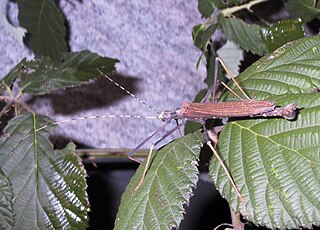
Pseudophasmatidae is a family of stick insect, in the suborder Verophasmatodea, commonly called the "striped walkingsticks". An important identifying characteristic is its mesothorax, which is never more than three times as long as the prothorax.
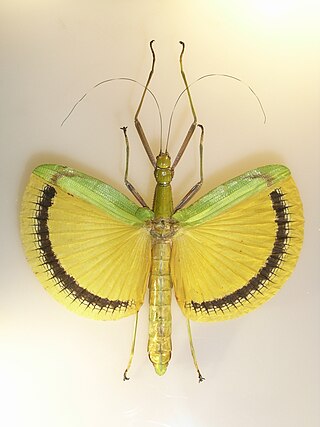
Necrosciinae is a subfamily of the stick insect family Lonchodidae, with its greatest diversity in South-East Asia.
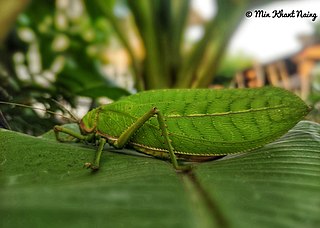
The subfamily Pseudophyllinae contains numerous species in the family Tettigoniidae, the katydids or bush crickets. Sometimes called "true katydids", together with the crickets of suborder Ensifera, they form part of the insect order Orthoptera which also contains grasshoppers.
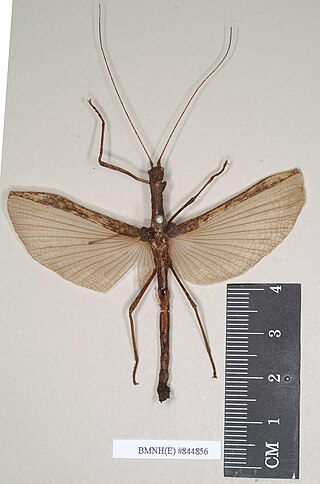
Sosibia is an Asian genus of stick insects in the family Lonchodidae and subfamily Necrosciinae.

Bacillidae is a stick insect family in the order Phasmatodea and the suborder Verophasmatodea.

The Copiphorini are a tribe of bush crickets or katydids in the family Tettigoniidae. Previously considered a subfamily, they are now placed in the subfamily Conocephalinae. Like some other members of Conocephalinae, they are known as coneheads, grasshopper-like insects with an extended, cone-shaped projection on their heads that juts forward in front of the base of the antennae.

Conocephalinae, meaning "conical head", is an Orthopteran subfamily in the family Tettigoniidae.

Agraeciini is a large tribe of bush crickets or katydids in the conehead subfamily, Conocephalinae.

The Listroscelidinae are a subfamily of the Tettigoniidae found in the Americas, Madagascar, and Australia. The genus Arachnoscelis has become better known to the public after being featured on the cover of Science in 2012.

Diapheromerini is a tribe of walkingsticks in the family Diapheromeridae. There are at least 30 genera Diapheromerini.

Oxyartes is a genus of stick insects in the family Lonchodidae and tribe Necrosciini; species records are from India through to Indochina.
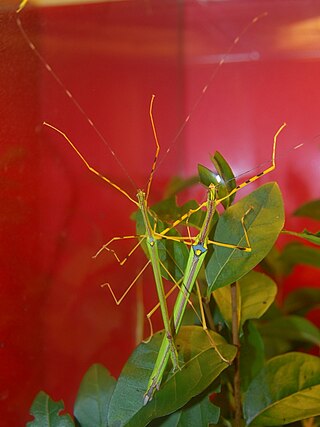
Necroscia is an Asian genus of stick insects in the family Lonchodidae and tribe Necrosciini. Species have been recorded from South-East Asia.

The Lonchodinae are a subfamily of stick insects in the family Lonchodidae found in: Australasia, Asia, Africa, Southern America and the Pacific.
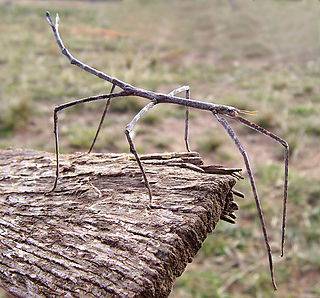
Phasmatini is a tribe of stick insects in the family Phasmatidae. There are more than 40 described species, found in Australasia, and Asia

The Platycraninae are an anareolate subfamily of stick insects in the family Phasmatidae. Their known distribution includes southern, southeast Asia and Australasia.

Anchiale is a genus of stick insects in the family Phasmatidae and tribe Phasmatini. Species have a known distribution from Australasia. The type species, A. maculata, was originally thought to be a Mantis.

The Cladomorphinae are a subfamily of stick insects in the family Phasmatidae. This taxon is particularly well represented in the Neotropical region, but records also exist for Madagascar, Java and the Maluku Islands.
Sadyattes is a genus of stick insects in the subfamily Platycraninae and tribe Stephanacridini. Species have a known distribution from Sumatra and Borneo.

















